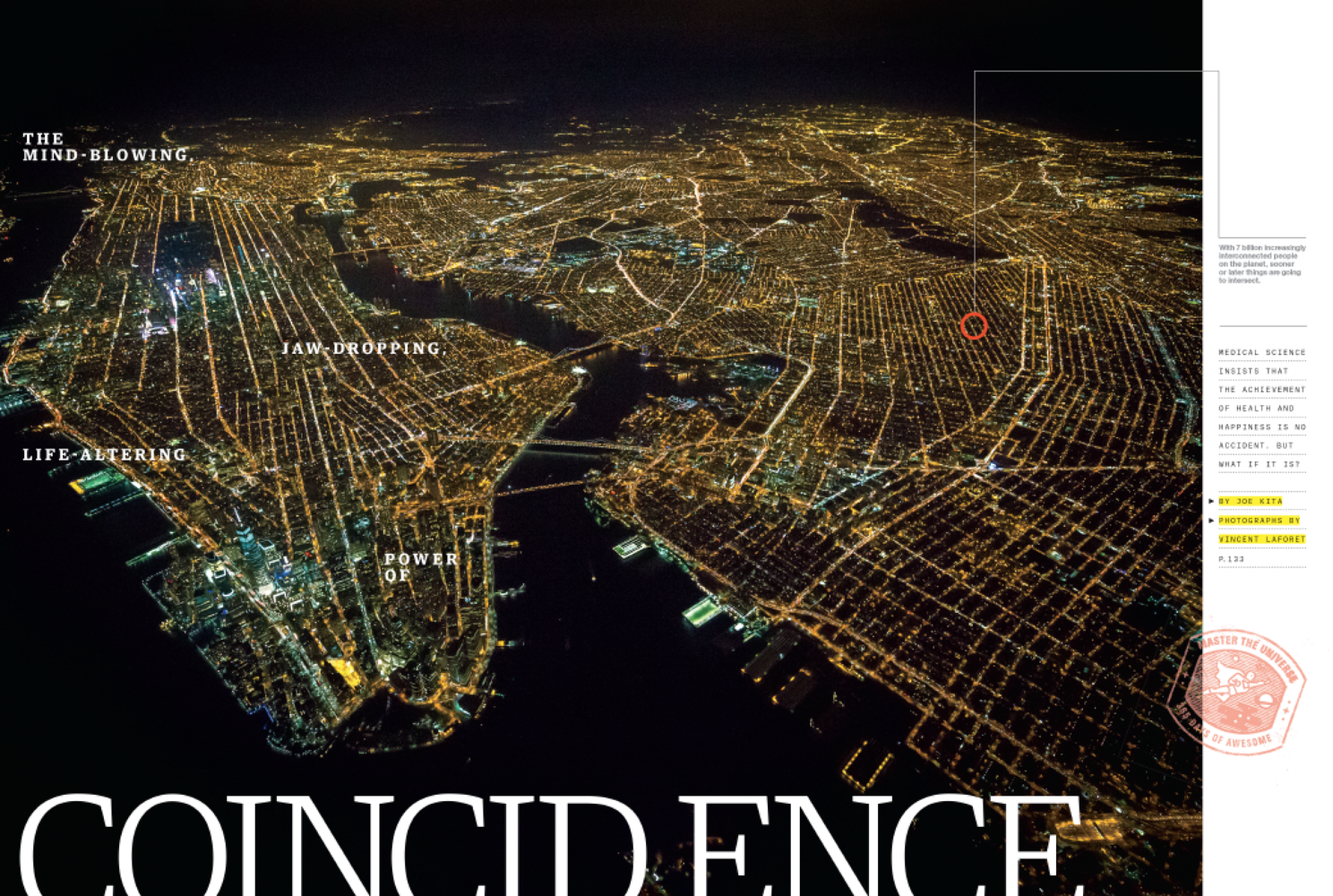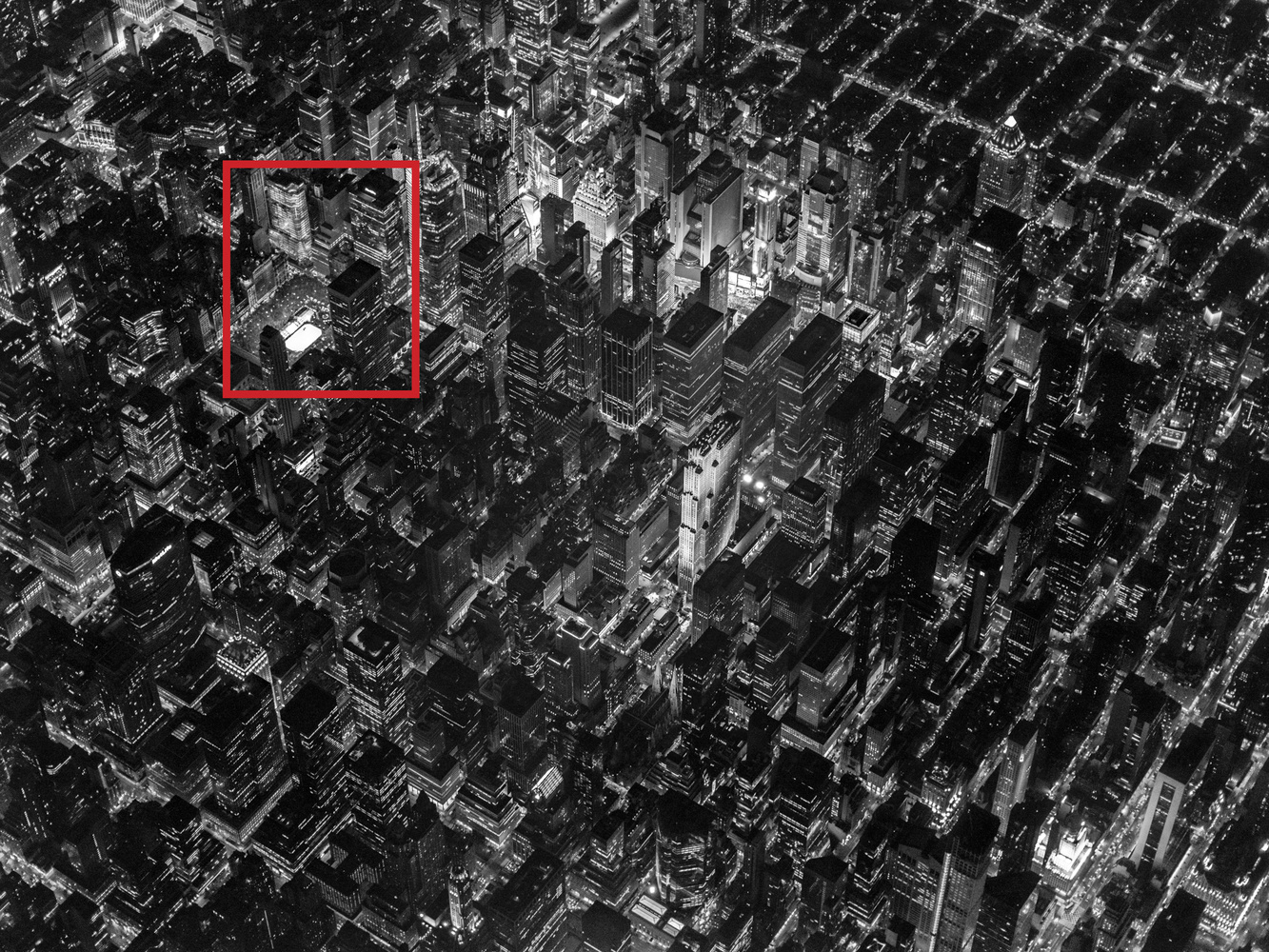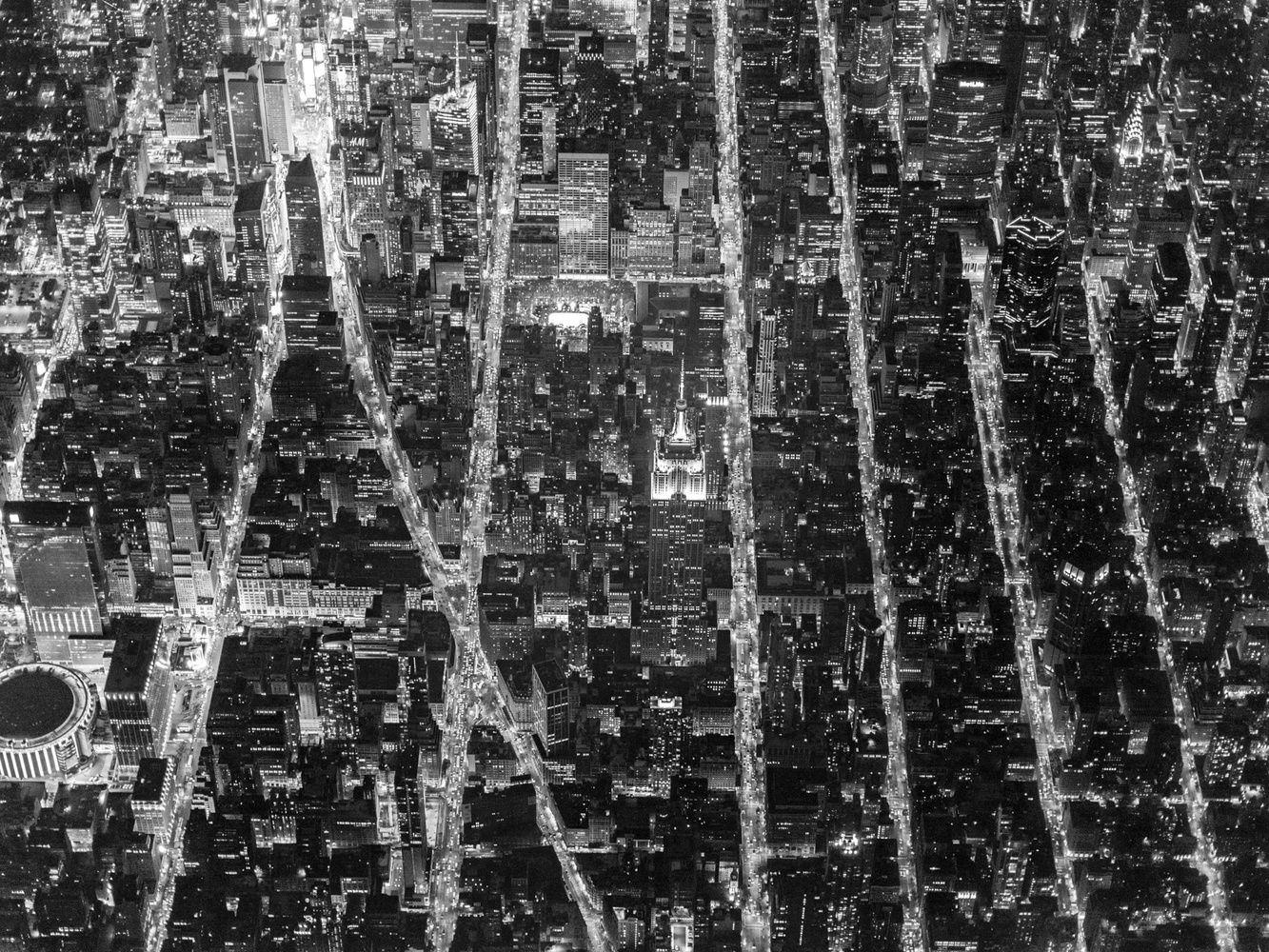Pressure, fear, joy, excitement – these are not uncommon emotions on any shoot. A few weeks ago, I spent a few hours in a helicopter above New York City with Vincent Laforet where we experienced all of these emotions. This exclusive interview and BTS video highlights not only what’s involved to produce aerial stills of this nature, but provides 5 key insights we can all apply to our own shoots.
We land after spending an hour hovering around 7000ft in the cold, dark night sky high above New York. Vincent sums up the mood succinctly: “Well, that was kind of scary. When it’s daylight and you’re lower, it’s one thing – but at night and at that height – it feels totally different”. Turns out this was not only a first for me, but for Vincent and Mike too. Night shoots from 7000ft above New York are not common.
The client, Men’s Health magazine, was running a story about chance and serendipity so they idea was to capture aerial shots that played on the idea of inter relationships between New Yorkers and the city itself.


Throughout this article and the video (below), you’ll get to see the final shots as they were being made for his client. You can check out all of the photographs from the shoot in more detail on Vincent’s site (Twitter: @vincentlaforet)
What It Feels Like To Fly High Above New York
Normally I tend to shoot most of what I see in New York City with my feet planted firmly on the ground. To get a sense of the job, you can check out the BTS video I shot and edited here:
Seeing the vast expanse of New York City stretching out far and wide across the landscape during both our daytime and (especially) the night time flight, was both beautiful and disconcerting. Like standing on the edge of a very tall building or mountaintop and peering over the edge, the sense of scale and expansive size of the city twinkling in the dark from 7000ft was intense.

Copyright Vincent Laforet

Copyright Vincent Laforet
The real learning took place when I spoke to Vincent both before and after he’d successfully shot what he’d needed. This sort of shoot is far from easy, but strangely enough, much of what it takes to pull off a successful aerial shoot can be applied to any number of genres or shoots we find ourselves in back on the ground.
So What Can We All Learn?
Everything I saw on this shoot was invaluable but here are the five main takeaways from watching Vincent, and his Aerial Tech, Mike Isler, in action.
1.) Plan Ahead
More than 50% of the job is planning. While you hope for serendipity and a special moment, you can’t rely on it. Mike and I had satellite images, with flight paths and coordinates printed out for ourselves - and more importantly for the pilot - along with a complete flight path prior to take off. We knew where we would be, at what time, and what the locations would look like before we even got to the heliport. We even knew where the building shadows would fall at specific times.
At a cost of about $6,000 for two hours (or $50 per minute) for flight time including special night and pilot fees, it goes without saying that you need to have your ducks in a row before you fly. Vincent and Mike had a substantial amount of gear to manage - multiple Canon 1DX’s, a Mamiya Leaf Credo 50MP digital medium format system, a huge array of glass for both Canon and Mamiya medium format system. In addition, Mike had brought a Kenyon 4x4 gyroscopic stabilizer for the night flight too, which provided stability for lower ISO, slower shutter night shots.
Mike Isler elaborated on the planning:
I use an aviation app called ForeFlight for flight planning. It’s loaded with all of the information I need. I use it during the planning phase and also the day of flight, to check the locations we’ll be shooting, see what airspace they fall in, and evaluate if that’ll present an issue. Flight restrictions (due to VIP visits or sporting events) are also depicted, as is all current weather and aviation forecasts. It’s a one-stop-shop for me.

Being able to know what you need to get and what shots you want with the gear on hand is critical. Running over on shoots like this is simply not an option. Whether you have to pay for air time, studio time or just manage your own time, going over on the time for the shoot is asking for trouble, especially as you book bigger and bigger client jobs. Managing our time effectively by planning ahead was absolutely critical, but the same can be said for any of us on almost any shoot.
2.) Good Communication Is Vital
Communication is the single most important skill that people take for granted in aerial photography. I have to translate what I’m seeing and anticipating to a pilot so that he can relay them to the Air Traffic Control to obtain and maintain our flight permission. You can’t just turn around or stop when you see something - it’s about staying several steps ahead of the game at all times.
In-air communication between Vincent and Mike was almost second nature (having a good partner to work with you is invaluable). Communication with the pilot was succinct, to the point and relaxed. I made it a point to listen to how Vincent and the pilot worked together, refining heading, altitude and orientation to get the shots Vincent needed. It was fascinating as the pilot relied on Vincent’s instructions as the often couldn’t see where they were relative to what he was shooting.
Like any shoot on the ground, running around and screaming and stressing out is never going to be conducive to a relaxed, productive or fun shoot. Slow, clear and relaxed communication in the air was key and the same can be said for us on the ground.

Copyright Vincent Laforet

Copyright Vincent Laforet

Copyright Vincent Laforet
Washington Square Park - the third of 3 carefully pre-planned locations
3.) All The Gear, With A Clear Idea
I had really specific photographs in mind when I went up with clear technical limitations that I knew I would face. It is still extremely dark at night, so we relied mostly on fast prime lenses. We used the Kenyon gyro to stabilize all the cameras at night. We shot with the 1DX because of it’s incredible low light performance, and high burst frame rate. With 10 frames a second, at 1/30th of a second shutter, you hope at least one is sharp, given the vibration and movement. We brought the medium format Mamiya system to get the highest possible image quality. Although we had somewhat slower lenses for that system, I was looking to capture the best possible detail available and it gave me that. This was the first time I was able to use digital medium format after sunset in the air.
The new Leaf Credo 50 CMOS sensors enabled Vincent to shoot at around 3200 ISO and still get a clean image. You can see from the crops here the level of detail the thing was able to capture.

Copyright Vincent Laforet
Columbus Circle shot in medium format

Copyright Vincent Laforet
Bryant Park medium format shot

Copyright Vincent Laforet
This area shows Bryant Park...

...and this shows the detail of the buildings surrounding the park

Copyright Vincent Laforet
Midtown shot with the Lead Credo 50MP system

Copyright Vincent Laforet
Selective crop of the Empire State looks like....

Copyright Vincent Laforet
...this. Notice the clarity of the windows and individual car lights. The Kenyon gyro undoubtably helped with stability for these medium format shots
Vincent and Mike had a clear shot list and knew what gear they would use at each location as part of their pre-planning. This helped Mike with his seamless configuration between the two 1DX’s and the Mamiya for the night shots.
You may not have anything more than a single camera body and a zoom lens or two, but knowing what type of shots you want, at each location ahead of your own shoot will allow you to be better prepared and to work efficiently. Don’t be afraid to take your gear and a friend out on location to pre-light or test with your lights and camera settings noted ahead of your actual shoot. Knowing your gear, and knowing when to apply each part of it will serve you much more effectively, especially as shoots inevitably grow in complexity and reduce in time on location.
4.) The Team Makes Or Breaks The Project
Mike and I have been working together for over a decade and over a million dollars worth of flight time, in dozens of helicopters around the world. I rely on him to make sure that everyone is safe in the helicopter, that the gear functions perfectly and that the entire flight runs smoothly, including necessary clearances, safety checks and all other flight considerations. We always try to fly with pilots we’ve flown with before as this work comes with a very specific skill set. I’ve flown with Liberty Helicopter for over a decade. The pilot is not only an integral part of our team but is the main person in charge of safety and I always defer to him or her.
Vincent, Mike and their pilots were a very integrated unit that communicated and worked well together effortlessly. Vincent said they always prefer to fly with pilots who have flown with them before and it certainly helps in general to work with those you’ve worked with before.
When we build our own creative teams, regardless of the size of the team, everyone should be considered an integral part of the shoot’s success. The most successful projects I have been involved in this year were not necessarily those with the biggest budgets – they were the ones where strong collaborative spirit was present.

Copyright Vincent Laforet
5.) Safety First
Safety is the number one concern. No loose objects, nothing in any pockets, and of course, we are harnessed in. and the cameras are harnessed to us at all times. Even if we were to hit a pocket of air and lose altitude rapidly nothing can fall out. Every photographer doing this sort of work should understand that if anything falls out of the helicopter, it has the potential to kill someone below. I always strongly urge people to ask more experienced pilots or aerial photographers for advice prior to undertaking any form of aerial photography.
One thing was clear throughout our two separate flights. Every single thing that could fall out, was secured to prevent it from doing so, or removed prior to flight time. Every lens change was done in such a way to avoid a dropped lens falling out of the helicopter.
Nothing was left to chance.
I’ve been on a number of shoots this year where I’ve acted as a lighting director, or gaffer. For most of us, light stands or electrical currents on set, especially with those on larger HMIs, provide areas where we need to focus to manage risk. Safety should come first, whether you’re in the studio or 7000ft above a densely populated city. Finally, just as Murphy’s Law reminds us that if something can happen, it will, always make sure you’re covered with proper liability insurance for those situations where things go wrong and were out of your control. It may sound boring, but safety should always be our number one concern.

Copyright Vincent Laforet
Times Square from 7000ft

Copyright Vincent Laforet
Tilt shift of the new WTC

Copyright Vincent Laforet
A 'miniaturized' tilt shift version of Times Square
Final Thoughts
This was undeniably an amazing experience to observe first hand. The level of skill and precision between the team was first rate. But the excitement was quickly replaced by a respect for the inherent challenges of getting the job done. Whether we find ourselves hanging on the outside of a helicopter or not, we can all apply the principles of pre-planning, clear communication, proper gear selection, team working and above all, safety, to our next shoot.

Special Thanks: [Vincent Laforet @vincentlaforet (Twitter / Instagram) / Mike Isler @mikeisler (Twitter / Instagram)]








Loved this article, specially sense I want to give aerial photography a try real soon, but man the price of a helicopter is not cheap (then again it being in New York and at night would explain why its more than here in Florida). My goal for next year is to do at least two shoots like this!
thanks Austin - yeah night flights and associated clearances (as well as up to 7000ft) probably accounted for extra cost - but it's not cheap.
Get a few friends together and split the cost - that might be one way to do it too :)
The photos are breathtaking! I particularly loved the ones with the people's silhouettes... their shadows seemed to stand on their own as individual characters!
Agree - i love how Vince captured the shadows - the low winter sun gave it a very interesting quality, with the shadows themselves almost becoming the focus
Really interesting article!
I had two similar experiences with a Belgian Aerial Photographer! One was in Switzerland (here is the BTS I shot for him : https://vimeo.com/97534328) and the second one was in Belgium, at the Tomorrowland electro music festival (BTS edit under construction)! He asked me to film his work, behind his lens! Awesome experiences! Hope there will be more!
However, thanks a lot for this analyse and those great advices!!
Simon
Thanks Simon, that BTS you shot is beautiful! Please message me when your Tomorrowland footage is done, would love to see it!
Wow! Stunning Photos. I have never seen New York like this before. It must have been a great learning experience.
Husain it was a very unique experience, I was very fortunate to be able to go. Hopefully the video gives a bit of the feeling of being there to you guys too, that was the aim anyways :)
I've always loved his aerial work. Really spectacular stuff.